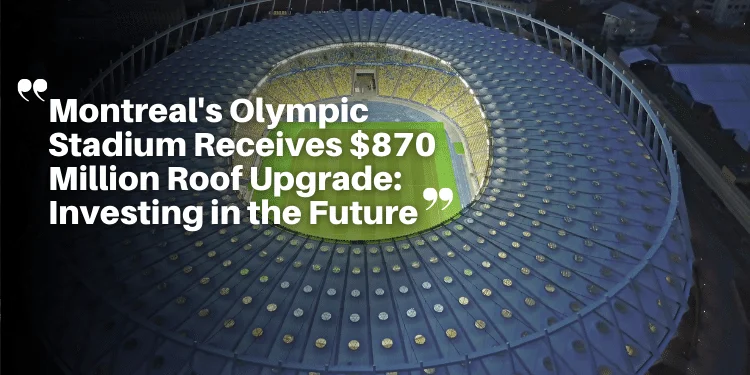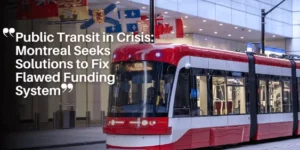Montreal’s Olympic Stadium Receives $870 Million Roof Upgrade: Investing in the Future
By: Emilly Correa Posted in: August 19, 2024 Last Update: August 13, 2025

The Imperative for Change
Gazing at Montreal’s Olympic Stadium, one can’t help but marvel at its grandeur. However, beneath its majestic facade lies a pressing issue: the deteriorating condition of its iconic roof. What was once an engineering marvel has succumbed to the passage of time and harsh weather conditions. With over 20,000 tears compromising its integrity, the stadium faces not only aesthetic challenges but also safety and functionality concerns.
Montreal’s Olympic Stadium Roof: A Critical State of Disrepair
The current state of the stadium’s roof is alarming. More than 20,000 tears mar its surface, posing a significant threat to its structural integrity. These tears, caused by years of exposure to Canadian winters and fluctuating weather patterns, create vulnerabilities that could lead to further damage. Addressing these issues is not a matter of cosmetic enhancement but a necessity to safeguard the stadium’s future.
The Risk of Closure Looms Due to Roof Damage
Without intervention, the stadium faces the imminent risk of closure within two years. The sheer number of tears increases the likelihood of water and snow infiltration, which could exacerbate structural damage. Closure would not only disrupt operations but also have far-reaching implications for the community, both culturally and economically.
The Urgent Need for the $870 Million Roof Replacement Investment
To mitigate these risks, a decisive step is required: a substantial investment of $870 million to replace the roof. This investment is not merely about cosmetic enhancements but about ensuring the stadium’s longevity and functionality. By revitalizing this iconic landmark, Montreal aims to preserve its cultural heritage and maintain a vital asset for future generations.
Economic Implications and Viability
Anticipated Revenue Growth with the Roof Upgrade
The proposed roof upgrade is not just about structural improvements; it’s also about unlocking economic potential. Projections indicate a significant increase in annual revenue, from $23 million to $61 million. This boost is attributed to the stadium’s enhanced appeal for hosting a wide range of events, from sports competitions to cultural festivals.
Skepticism Surrounding Economic Projections
However, skepticism exists regarding the feasibility of these revenue projections. Critics, including sports economists, question the validity of such optimistic forecasts. They highlight past instances where stadium upgrades failed to deliver promised economic benefits, citing hidden costs and overestimated event frequencies.
Balancing Economic Viability with Long-Term Benefits
The debate surrounding Montreal’s Olympic Stadium revolves around striking a balance between short-term economic gains and long-term community benefits. While the upgraded roof could attract more events and visitors, the hefty investment prompts reflection on alternative uses of funds, such as healthcare or education initiatives.
Preserving Cultural Heritage and Symbolism
Historical and Cultural Significance of the Olympic Stadium
Montreal’s Olympic Stadium is not just a sports venue; it’s a symbol of the city’s history and progress. Built for the 1976 Summer Olympics, it has since become ingrained in the city’s social fabric, hosting various events and gatherings. Preserving this iconic landmark is essential for honoring Montreal’s past achievements and maintaining its unique identity.
The Stadium as a Emblematic Landmark of Montreal
Advocates for preserving the stadium emphasize its symbolic importance to Montreal. Like the Eiffel Tower to Paris, the Olympic Stadium’s silhouette defines the city’s skyline and evokes pride among its residents. Its preservation is crucial for preserving Montreal’s architectural diversity and global image.
Potential for Increased Tourism and Cultural Activity
With the new roof, the stadium’s potential as a cultural and tourism hub is amplified. It can attract a broader range of events throughout the year, contributing to increased foot traffic and economic activity in the surrounding areas. This aligns with Montreal’s goal of enhancing its appeal as a vibrant destination for locals and visitors alike.
Considering Alternatives and Community Priorities
Cost-Benefit Analysis of Stadium Investment
While the stadium renovation promises economic benefits, it also raises questions about resource allocation. Critics argue that the $870 million investment could be directed towards more immediate societal needs, such as infrastructure or social services. Balancing the cultural significance of the stadium with practical community priorities is essential in making informed decisions.
Exploring Alternative Uses of Funds
Alternative projects, such as public transportation improvements or affordable housing initiatives, present viable alternatives to stadium renovation. These projects offer tangible benefits to the community and address pressing social and economic challenges. Assessing the long-term impact of each investment option is crucial for maximizing public value.
Conclusion: Shaping Montreal’s Future
The renovation of Montreal’s Olympic Stadium is not just about repairing a roof; it’s about shaping the city’s future. By investing in cultural landmarks and infrastructure, Montreal aims to preserve its heritage and stimulate economic growth. However, this decision necessitates careful consideration of economic viability and community priorities. As Montreal embarks on this transformative journey, it seeks to strike a balance between honoring its past and building a prosperous future for generations to come.
Author
-

Emilly Correa has a degree in journalism and a postgraduate degree in digital marketing, specializing in content production for social media. With experience in copywriting and blog management, she combines her passion for writing with digital engagement strategies. She has worked in communications agencies and now dedicates herself to producing informative articles and trend analyses.






